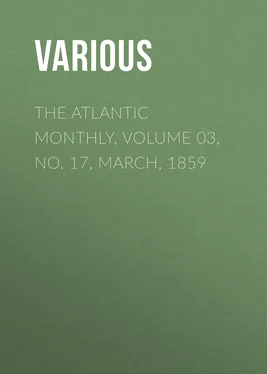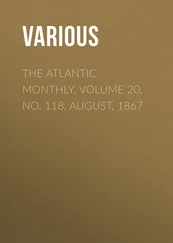Various - The Atlantic Monthly, Volume 03, No. 17, March, 1859
Здесь есть возможность читать онлайн «Various - The Atlantic Monthly, Volume 03, No. 17, March, 1859» — ознакомительный отрывок электронной книги совершенно бесплатно, а после прочтения отрывка купить полную версию. В некоторых случаях можно слушать аудио, скачать через торрент в формате fb2 и присутствует краткое содержание. Жанр: foreign_antique, periodic, foreign_edu, на английском языке. Описание произведения, (предисловие) а так же отзывы посетителей доступны на портале библиотеки ЛибКат.
- Название:The Atlantic Monthly, Volume 03, No. 17, March, 1859
- Автор:
- Жанр:
- Год:неизвестен
- ISBN:нет данных
- Рейтинг книги:5 / 5. Голосов: 1
-
Избранное:Добавить в избранное
- Отзывы:
-
Ваша оценка:
- 100
- 1
- 2
- 3
- 4
- 5
The Atlantic Monthly, Volume 03, No. 17, March, 1859: краткое содержание, описание и аннотация
Предлагаем к чтению аннотацию, описание, краткое содержание или предисловие (зависит от того, что написал сам автор книги «The Atlantic Monthly, Volume 03, No. 17, March, 1859»). Если вы не нашли необходимую информацию о книге — напишите в комментариях, мы постараемся отыскать её.
The Atlantic Monthly, Volume 03, No. 17, March, 1859 — читать онлайн ознакомительный отрывок
Ниже представлен текст книги, разбитый по страницам. Система сохранения места последней прочитанной страницы, позволяет с удобством читать онлайн бесплатно книгу «The Atlantic Monthly, Volume 03, No. 17, March, 1859», без необходимости каждый раз заново искать на чём Вы остановились. Поставьте закладку, и сможете в любой момент перейти на страницу, на которой закончили чтение.
Интервал:
Закладка:
In England, Holbein found a friend and patron in Sir Thomas More,—Henry the Eighth's great Lord Chancellor; and a sight of some of his works won him, ere long, the favor of the King himself. He was appointed Court Painter, with apartments at the palace, and a yearly salary of two hundred florins, (or thirty pounds, equal to about two hundred pounds now,) which he received in addition to the price of his pictures. After about three years of prosperity he went home to his wife and children; but as he soon returned to England, we may safely conclude that his visit was to provide for the latter, and with no hope of living with the former. Some years after, in 1538, when his fame was still increasing, the city of Bâle, proud of its son, offered him a handsome annuity, in the hope that that might induce him to return to his country, his children, and his wife. But he could not be tempted. Though not the wisest of men, he was Solomon enough to know that "it is better to dwell in a corner of the house-top than with a brawling woman and in a wide house"; and as he was successful and held in honor in England as well as Bâle, he contented himself with a corner of King Henry's palace.
But although he fled from his wife, he painted her portrait; and we need no testimony to warrant the likeness. She is the very type of one of those meek shrews, alternately a martyr and a fury, that drive a man to madness when they speak and to despair when they are silent. We might reasonably wonder that he would paint so vivid a representation of that which he so sedulously shunned. But poor Hans, who probably had some lingering remains of his early love, knew, that, although he should make a speaking likeness, it would be a silent one, and that this Frau Holbein must keep the look which he chose to summon to her face. That, indeed, was knowledge that was power! How he must have chuckled as he saw his wife looking at him more natural than life and yet without the power to worry him! His own portrait shows us a broad, good-natured, ruddy face, in which we see marks of talent when we know that it is Holbein's. But in spite of its strength, its bronze, and its beard, it has a somewhat sad and subdued air; and its heavy-lidded, pensive eyes look deprecatingly at a Frau Holbein in the distance.
While he lived at Greenwich palace, an incident occurred which may not be known to all our readers, and which is a striking illustration of the esteem in which he was held by Henry. It is not a little to the honor of that monarch, who, arbitrary and sensual as he was, had some noble traits of character. One day, as Holbein was painting a lady's portrait in his private studio, a nobleman intruded upon him rudely. Holbein resented the discourtesy, and, as it was doggedly persisted in, finally threw my lord downstairs. There was an outcry; and the painter, bolting his door on the inside, escaped from his window along the eaves of the roof, and, making his way directly to the King, threw himself before him and begged a pardon, without telling his offence. Henry promised forgiveness on condition of a full confession, which the painter began. But meantime the nobleman arrived, and Henry, in deference to his rank, gave him precedence, and stepped into another apartment to hear his story. He accused Holbein of the violence, but suppressed the provocation; whereat Henry broke into a towering Tudor rage, and, after reproaching the nobleman for his prevarication, said, "You have to do with me, Sir. I tell you, that of seven peasants I could make seven earls like you; but of seven earls I could not make one Holbein. Do not molest him, if you value your head." And as second-hand heads, though plentiful about those days, were found to be of no value, even to the original owner, Holbein remained unmolested.
Holbein is known chiefly by his portraits. He painted some historical and sacred pictures; but though they all bear witness to his genius, it can hardly be denied that they also show that that genius was not suited to such works. Holbein had an objective perception;—that is, his mind received impressions entirely uninfluenced by its own character or condition; and his pictures, therefore, seem like literal transcripts of what was before his eyes. He nowhere shows that he had an idea of abstract beauty, or the power of generalizing from individuals, or that he was at all discontented with the subjects which he painted; so that his works leave an impression of absolute faithfulness. But to suppose, therefore, that his portraits have merely the merit of reproducing the external facts of Nature, like photographs, would do him wrong; for he was faithful to expression as well as form, and has perpetuated upon his canvas the voluptuous sweetness of Anne Boleyn, the courtliness and manly grace of Wyatt, and the severity, the energy, and the penetrating judgment of Sir Thomas More. His portrait of the last is one of the greatest portraits ever painted. Some competent critics consider it the greatest. It is so real, so human, that we might be well content, if one in twenty of the actual men we meet were half as real and human; and it expresses, with equal strength and subtilty, the large and noble nature of the man. Holbein was a great colorist, and imitated all the rich and tender hues of Nature, in their delicate and almost imperceptible gradations, with a minute truthfulness which is quite marvellous.
This being the character of his mind, it would hardly be supposed that he could produce such a work as the great Dance of Death, which has caused all others to be forgotten, except by antiquarians. For this Dance is the most remarkable embodiment in Art of that fantastic and grotesque idealism which has found its best expression in the works of German poets and painters; and the preëminence of Holbein's over all the other representations of the same subject consists in this,—that, while they are but a dull and formal succession of mere costumed figures seized by a corpse and shrinking away from its touch, Holbein's groups are instinct with life, character, and emotion. In particular is this true of the figure of Death, although it is a mere skeleton,—the face without a muscle, and for the eye but a rayless cavern. Death is not one whom "a limner would love to paint or a lady to look upon"; but Holbein has given a strange and fascinating interest to the figure, which in all other hands is merely repulsive. The grim monarch sat to a painter who not only added to the truthfulness of his portrait the charm of poetic feeling, but the magic touch of whose pencil made his dry bones live.
The insignificance of the material in which the painter worked, when compared with the effect which he produced, is also remarkable in this unique work of Art. For Holbein's Dance of Death is not, like the others, either a great fresco painting, or a series of sculptures; it is not a painting at all,—but merely a series of very small woodcuts, fifty-three in number, forty-six of which were published at Lyons in 1538, and the whole afterwards at Bâle in 1554, under the title, Simulachres de la Mort, Icones Mortis: that is, in French and Latin, "Images of Death,"—for the title "Dance of Death" is of recent origin. The leaves on which the cuts are printed make but part of a little book not so large as a child's primer; but a copy of it is now worth ten times its weight in gold. It was copied and republished in numberless editions, as a popular book, merely for the sake of the subject, and the great lesson taught by it,—each print being accompanied by an admonitory stanza, and a quotation from the Bible. Beside these editions, endeavors have been made of later years to imitate it satisfactorily as a work of Art,—but in vain. Great as we think our advancement in the arts has been,—the mechanical part of them, at least,—all the efforts of the lithographer, the wood-cutter, and even the line-engraver, to reproduce the spirit or the very lines of this work, have been but partially successful. There is as much difference between the most carefully-executed and costliest copies and good impressions of the original wood-cuts, made three hundred years ago, and sold for a franc or two, as there is between pinchbeck and gold.
Читать дальшеИнтервал:
Закладка:
Похожие книги на «The Atlantic Monthly, Volume 03, No. 17, March, 1859»
Представляем Вашему вниманию похожие книги на «The Atlantic Monthly, Volume 03, No. 17, March, 1859» списком для выбора. Мы отобрали схожую по названию и смыслу литературу в надежде предоставить читателям больше вариантов отыскать новые, интересные, ещё непрочитанные произведения.
Обсуждение, отзывы о книге «The Atlantic Monthly, Volume 03, No. 17, March, 1859» и просто собственные мнения читателей. Оставьте ваши комментарии, напишите, что Вы думаете о произведении, его смысле или главных героях. Укажите что конкретно понравилось, а что нет, и почему Вы так считаете.












